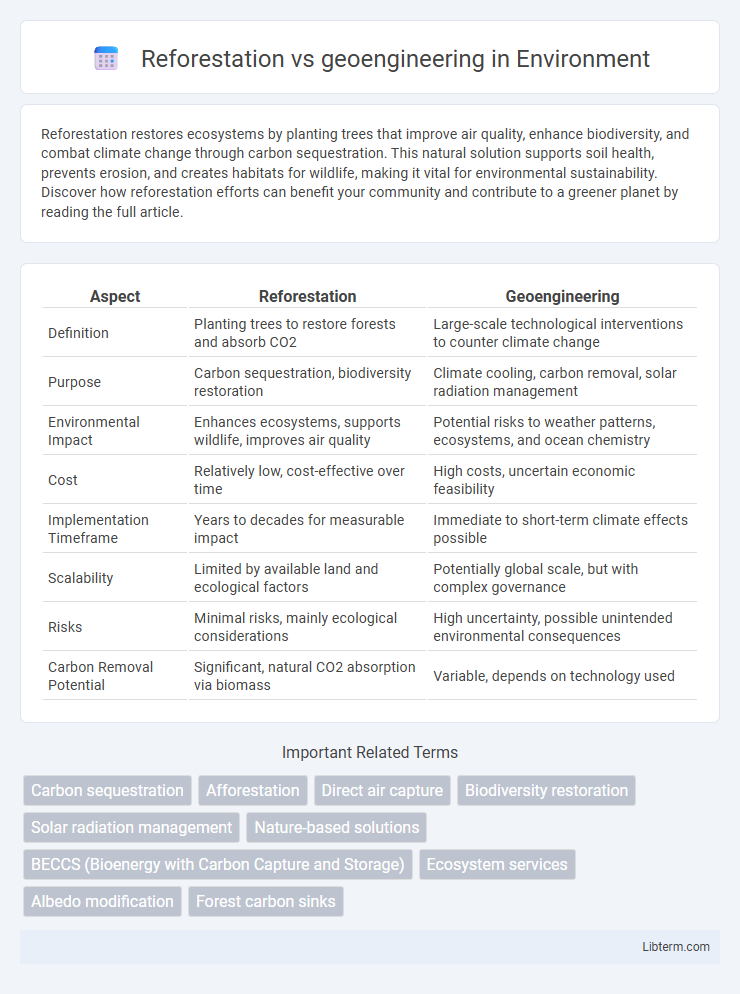Reforestation restores ecosystems by planting trees that improve air quality, enhance biodiversity, and combat climate change through carbon sequestration. This natural solution supports soil health, prevents erosion, and creates habitats for wildlife, making it vital for environmental sustainability. Discover how reforestation efforts can benefit your community and contribute to a greener planet by reading the full article.
Table of Comparison
| Aspect | Reforestation | Geoengineering |
|---|---|---|
| Definition | Planting trees to restore forests and absorb CO2 | Large-scale technological interventions to counter climate change |
| Purpose | Carbon sequestration, biodiversity restoration | Climate cooling, carbon removal, solar radiation management |
| Environmental Impact | Enhances ecosystems, supports wildlife, improves air quality | Potential risks to weather patterns, ecosystems, and ocean chemistry |
| Cost | Relatively low, cost-effective over time | High costs, uncertain economic feasibility |
| Implementation Timeframe | Years to decades for measurable impact | Immediate to short-term climate effects possible |
| Scalability | Limited by available land and ecological factors | Potentially global scale, but with complex governance |
| Risks | Minimal risks, mainly ecological considerations | High uncertainty, possible unintended environmental consequences |
| Carbon Removal Potential | Significant, natural CO2 absorption via biomass | Variable, depends on technology used |
Introduction: Reforestation vs Geoengineering
Reforestation involves planting trees to restore ecosystems, enhance carbon sequestration, and improve biodiversity, offering a natural and sustainable approach to climate mitigation. Geoengineering encompasses large-scale technological interventions like solar radiation management or carbon capture to directly alter Earth's climate system and reduce global warming. Both strategies aim to combat climate change but differ significantly in methodology, risks, and long-term ecological impacts.
Understanding Reforestation
Reforestation involves planting trees to restore deforested areas, enhancing carbon sequestration and improving biodiversity. It helps stabilize ecosystems, increase soil fertility, and regulate water cycles, making it a natural climate solution with long-term benefits. Unlike geoengineering, which relies on technological interventions, reforestation supports environmental resilience by promoting natural processes for carbon capture.
Exploring Geoengineering Techniques
Geoengineering techniques such as solar radiation management and carbon dioxide removal offer scalable solutions to mitigate climate change by directly altering Earth's systems, contrasting with reforestation's reliance on natural carbon sequestration processes. Techniques like stratospheric aerosol injection and ocean fertilization aim to reduce global temperatures or enhance carbon sinks but raise concerns regarding ecological risks and governance challenges. Evaluating the effectiveness and ethical implications of geoengineering requires comprehensive climate modeling and international regulatory frameworks to complement traditional reforestation efforts.
Climate Impact: Trees vs Technology
Reforestation enhances carbon sequestration by absorbing CO2 naturally, improving biodiversity and soil health, which supports long-term climate stability. Geoengineering technologies, such as solar radiation management and carbon capture, offer rapid climate modulation but carry uncertainties regarding ecosystem disruption and governance challenges. Integrating reforestation with responsible geoengineering could balance immediate climate mitigation with sustainable environmental benefits.
Cost and Resource Comparison
Reforestation requires substantial land area, water, and labor investments but offers long-term carbon sequestration benefits with co-benefits for biodiversity and ecosystem services. Geoengineering techniques, such as solar radiation management or carbon capture and storage, often entail high upfront technological costs and uncertain environmental risks but can be deployed more rapidly at a global scale. Comparing costs, reforestation typically demands lower financial resources yet greater time commitments, while geoengineering may involve higher financial and energy inputs with potential dependency on continuous maintenance.
Ecological Benefits and Risks
Reforestation enhances biodiversity, improves carbon sequestration, and restores natural habitats, significantly benefiting ecosystem stability and climate regulation. Geoengineering offers rapid climate intervention through techniques like solar radiation management, but carries risks such as ecological imbalance, unintended weather changes, and potential disruption of natural biogeochemical cycles. The ecological benefits of reforestation are long-term and well-studied, whereas geoengineering remains uncertain with possible adverse environmental consequences.
Societal and Ethical Considerations
Reforestation enhances biodiversity and supports indigenous communities by restoring natural habitats and promoting sustainable livelihoods, while geoengineering raises ethical concerns over governance, environmental risks, and potential unintended consequences impacting future generations. Social equity issues arise as geoengineering technologies may be controlled by a few powerful entities, potentially exacerbating global inequalities. Ethical debates emphasize the precautionary principle, advocating for transparent decision-making and inclusive stakeholder engagement to balance technological interventions with preserving ecological integrity.
Implementation Challenges
Reforestation faces implementation challenges such as land availability, long growth periods, and competition with agricultural land. Geoengineering methods, including solar radiation management and carbon capture, encounter regulatory hurdles, high costs, and uncertainties about long-term environmental impacts. Both approaches require coordinated policy frameworks and robust monitoring systems to address ecological risks and ensure effective climate mitigation.
Case Studies and Real-World Examples
Reforestation projects in Costa Rica have successfully sequestered millions of tons of CO2 by restoring degraded land, demonstrating natural carbon capture's efficacy and biodiversity benefits. In contrast, geoengineering experiments like the Stratospheric Controlled Perturbation Experiment (SCoPEx) aim to reflect sunlight to cool the planet but remain controversial due to ecological risks and governance challenges. Comparative analyses show reforestation offers co-benefits for ecosystems, while geoengineering could provide rapid climate mitigation but with uncertain long-term consequences.
Future Outlook and Strategic Recommendations
Reforestation offers a scalable, nature-based solution with long-term carbon sequestration and biodiversity benefits, while geoengineering presents rapid but uncertain climate interventions that require rigorous governance frameworks. Strategic recommendations emphasize integrating reforestation into national climate policies to enhance ecosystem resilience and investing in geoengineering research that prioritizes environmental safety and ethical considerations. Future outlooks favor a hybrid approach combining sustainable land management and cautious technological innovation to effectively mitigate climate change impacts.
Reforestation Infographic

 libterm.com
libterm.com